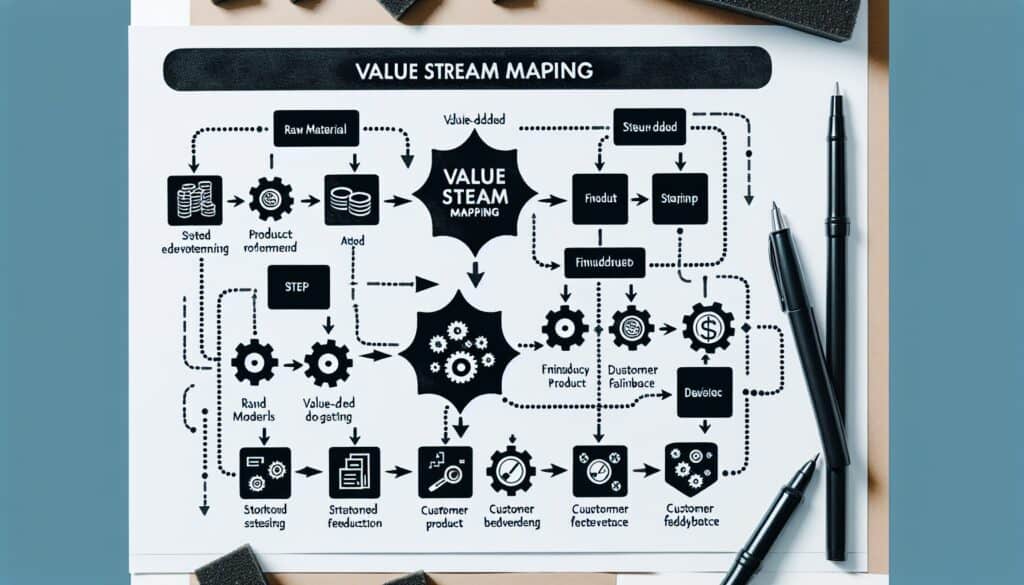Herramienta de gestión Lean que permite visualizar, analizar y mejorar todas las etapas (con y sin valor añadido) del proceso de entrega de un producto o servicio, desde la materia prima hasta el cliente.
- Metodologías: Ingeniería, Ergonomía
Mapeo del flujo de valor (VSM)

Mapeo del flujo de valor (VSM)
- Mejora continua, Manufactura esbelta, Producción ajustada, Mejora de procesos, Mapeo de procesos, Análisis de valor, Ingeniería de valor (VE), Mapeo del flujo de valor, Estrategias de eliminación de residuos
Objetivo:
Cómo se utiliza:
- Consiste en crear un "mapa del estado actual" que muestre el flujo de material e información e identifique los residuos y los cuellos de botella. A continuación, se diseña un "mapa del estado futuro" con mejoras para reducir los residuos y mejorar el flujo, seguido de un plan de implantación.
Ventajas
- Proporciona una visión holística de todo el flujo del proceso; Ayuda a identificar y eliminar los residuos (muda) y mejorar el plazo de entrega; Facilita el pensamiento a nivel de sistema en lugar de la optimización de procesos aislados; Herramienta visual que mejora la comunicación.
Contras
- Su creación puede ser compleja y requerir mucho tiempo, sobre todo en el caso de flujos de valor de gran tamaño; requiere la participación activa de un equipo interfuncional; la realización del estado futuro exige un esfuerzo y una gestión del cambio considerables.
Categorías:
- Lean Sigma, Fabricación, Resolución de problemas, Gestión de proyectos, Calidad
Ideal para:
- Identificar y eliminar los residuos en un proceso para mejorar el flujo, reducir el plazo de entrega y aumentar el valor entregado al cliente.
Value Stream Mapping (VSM) serves as a powerful methodology across various sectors such as manufacturing, healthcare, and software development, where understanding the flow of value is paramount. In manufacturing, for example, automotive companies utilize VSM to visualize workshop processes, enabling them to pinpoint inefficiencies between assembly lines and material handling systems. In healthcare, hospitals apply VSM to optimize patient flow, thereby enhancing service delivery while minimizing waiting times. This methodology is particularly effective in the initial phases of a project where mapping current operations can yield significant improvements. Participants typically include cross-functional teams comprising engineers, operators, and stakeholders who contribute diverse perspectives on process challenges and opportunities. Conducting regular workshops or Kaizen events can invigorate this practice, encouraging continuous updates to both current and future state maps as processes evolve. A hallmark of VSM is its visual nature, which not only simplifies complex workflows but also promotes enhanced communication among team members, fostering a shared understanding of goals and metrics that drive performance improvements. Exporting VSM findings into action plans sets a structured path for change, leading to measurable reductions in cycle times and increases in customer satisfaction. The collaborative approach reinforces a culture of continuous improvement, supporting organizations in their pursuit of principios lean while establishing a framework for sustainable operational excellence.
Pasos clave de esta metodología
- Create a current state map illustrating material and information flow.
- Identify areas of waste and bottlenecks within the current state map.
- Analyze identified wastes and prioritize them based on impact.
- Design a future state map featuring improvements to enhance flow.
- Develop an implementation plan detailing actions to achieve the future state.
- Establish metrics to measure improvements post-implementation.
- Communicate the future state and implementation plan to stakeholders.
- Execute the implementation plan and monitor progress regularly.
Consejos profesionales
- Incorporate feedback loops into the VSM process to enable continuous improvement and real-time adjustments.
- Utilize data-driven metrics alongside qualitative observations to inform the current state analysis for a more robust mapping.
- Engage cross-functional teams during both mapping phases to ensure diverse perspectives and enhance collaborative problem-solving.
Leer y comparar varias metodologías, recomendamos el
> Amplio repositorio de metodologías <
junto con otras más de 400 metodologías.
Sus comentarios sobre esta metodología o información adicional son bienvenidos en la dirección sección de comentarios ↓ , así como cualquier idea o enlace relacionado con la ingeniería.
Contexto histórico
1949
1950
1950
1960
1960
1960
1960
1940
1950
1950
1958
1960
1960
1960
1960
(si se desconoce la fecha o no es relevante, por ejemplo "mecánica de fluidos", se ofrece una estimación redondeada de su notable aparición)















Publicaciones relacionadas
Cuestionarios sobre molestias musculoesqueléticas
Pruebas multivariantes (MVT)
Análisis de regresión múltiple
Sistemas de captura de movimiento
Método MoSCoW
Prueba de la mediana de Mood